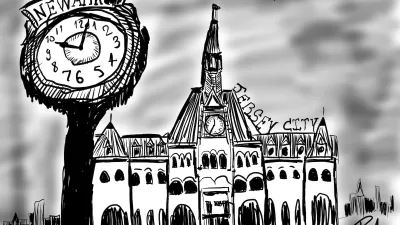While it is still in the early stages, it's nonetheless exciting to post that Hoboken and Jersey City are collaborating with Hudson County Transportation Management Association (TMA) to explore ways to bring a full-fledged bike sharing program to the west coast of the Hudson. The full details are posted in a Request for Expressions of Interest (RFEOI) here:http://www.hudsontma.org/index.php?option=com_content&task=view&id=227&cat_id=21&Itemid=61
While it is still in the early stages, it's nonetheless exciting to post that Hoboken and Jersey City are collaborating with Hudson County Transportation Management Association (TMA) to explore ways to bring a full-fledged bike sharing program to the west coast of the Hudson. The full details are posted in a Request for Expressions of Interest (RFEOI) here:
http://www.hudsontma.org/index.php?option=com_content&task=view&id=227&cat_id=21&Itemid=61
Interestingly, the concept includes a strategy that seeks complementary user groups; namely, residential commuters attracted to the transportation hubs during peak periods in the traditional commute directions, and tourists attracted to the NJ waterfront to see the NYC skyline and the Statue of Liberty during the off-peak periods in the reverse-commute directions. The result, in theory, is a system that could be implemented across a large area and several municipalities that meshes well with existing transport (i.e. ferries in need of off-peak ridership). The complementary travel patterns are paired to maximize utilization and minimize the need for regular staff-supported redistribution of bicycles. Kudos to the TMA for taking the leadership role on this!
This effort rides on the coattails of an announcement late last year of a federally-funded bike share program in Newark, NJ via the North Jersey Transportation Planning Authority (NJTPA) Congestion Mitigation and Air Quality (CMAQ) local Mobility Initiatives program and operated by non-profit organization Meadowlink. That bike share program is meant to pair commuters with local university students who share complementary commuting patterns. The strategy here is again to insert bike sharing where the travel patterns can support continued use of the equipment and keep redistribution to a minimum.
Bike sharing is a critical next step in these, and other urban municipalities, because there is a strong, dense connection between robust transportation centers and surrounding neighborhoods that can be served with a "one size fits all" solution. Bicycles used in a share model are a tantalizing niche because they take up significantly less space on streets and travel at "human speeds" that are much better matched to urban living than expanded use of automobiles and, in cases where distances are short, even redundant private shuttle systems. Bicycles are also quiet and contribute nothing to urban pollution and smog concerns. Still, bike sharing is still relatively new so many of the grander implementations (Paris, London, Montreal, and soon, New York City) are being closely watched in hopes of discovering the best model.
That said, it is hard to imagine that bike sharing will not become a critical option in the urban multi-modal menu of all cities. In my experience, the greatest practical challenge for expanding bicycle use in urban areas as a transportation option is the limited space residents have to safely keep bicycles at home. Small city flats in walk-up buildings are simply not ideal for owning and regularly using a bicycle, and many people are unwilling to spend money on a material possession that spends its nights on the street (and doesn't weigh two tons). Bike sharing circumvents these challenges by making the bicycle available as a "service" rather than a "possession", which eliminates the need to store the bicycle at home and removes the safety/security concerns from the individual. It also naturally allows bicycles to be used more continuously throughout the day, reducing resource consumption as well as the total number of bicycles in a city (which at some point can become overwhleming as anyone who has witnessed a Shanghai commute can attest!).
While I freely disclose involvement in the preparation of this RFEOI, the efforts are of a much larger group and the results are to the benefit of the participating communitites. It is exciting to think that such a partnership can allow for a system that promises so much benefit to some of the densest communities in the country. As with other projects Hoboken has attempted, the hope is that the ideal conditions of our and neighboring cities for demosntrating progressive solutions will serve as a model for how to do the same in so many other places.

Alabama: Trump Terminates Settlements for Black Communities Harmed By Raw Sewage
Trump deemed the landmark civil rights agreement “illegal DEI and environmental justice policy.”

Study: Maui’s Plan to Convert Vacation Rentals to Long-Term Housing Could Cause Nearly $1 Billion Economic Loss
The plan would reduce visitor accommodation by 25% resulting in 1,900 jobs lost.

Planetizen Federal Action Tracker
A weekly monitor of how Trump’s orders and actions are impacting planners and planning in America.

Wind Energy on the Rise Despite Federal Policy Reversal
The Trump administration is revoking federal support for renewable energy, but demand for new projects continues unabated.

Passengers Flock to Caltrain After Electrification
The new electric trains are running faster and more reliably, leading to strong ridership growth on the Bay Area rail system.

Texas Churches Rally Behind ‘Yes in God’s Back Yard’ Legislation
Religious leaders want the state to reduce zoning regulations to streamline leasing church-owned land to housing developers.
Urban Design for Planners 1: Software Tools
This six-course series explores essential urban design concepts using open source software and equips planners with the tools they need to participate fully in the urban design process.
Planning for Universal Design
Learn the tools for implementing Universal Design in planning regulations.
Caltrans
Smith Gee Studio
Institute for Housing and Urban Development Studies (IHS)
City of Grandview
Harvard GSD Executive Education
Toledo-Lucas County Plan Commissions
Salt Lake City
NYU Wagner Graduate School of Public Service




























